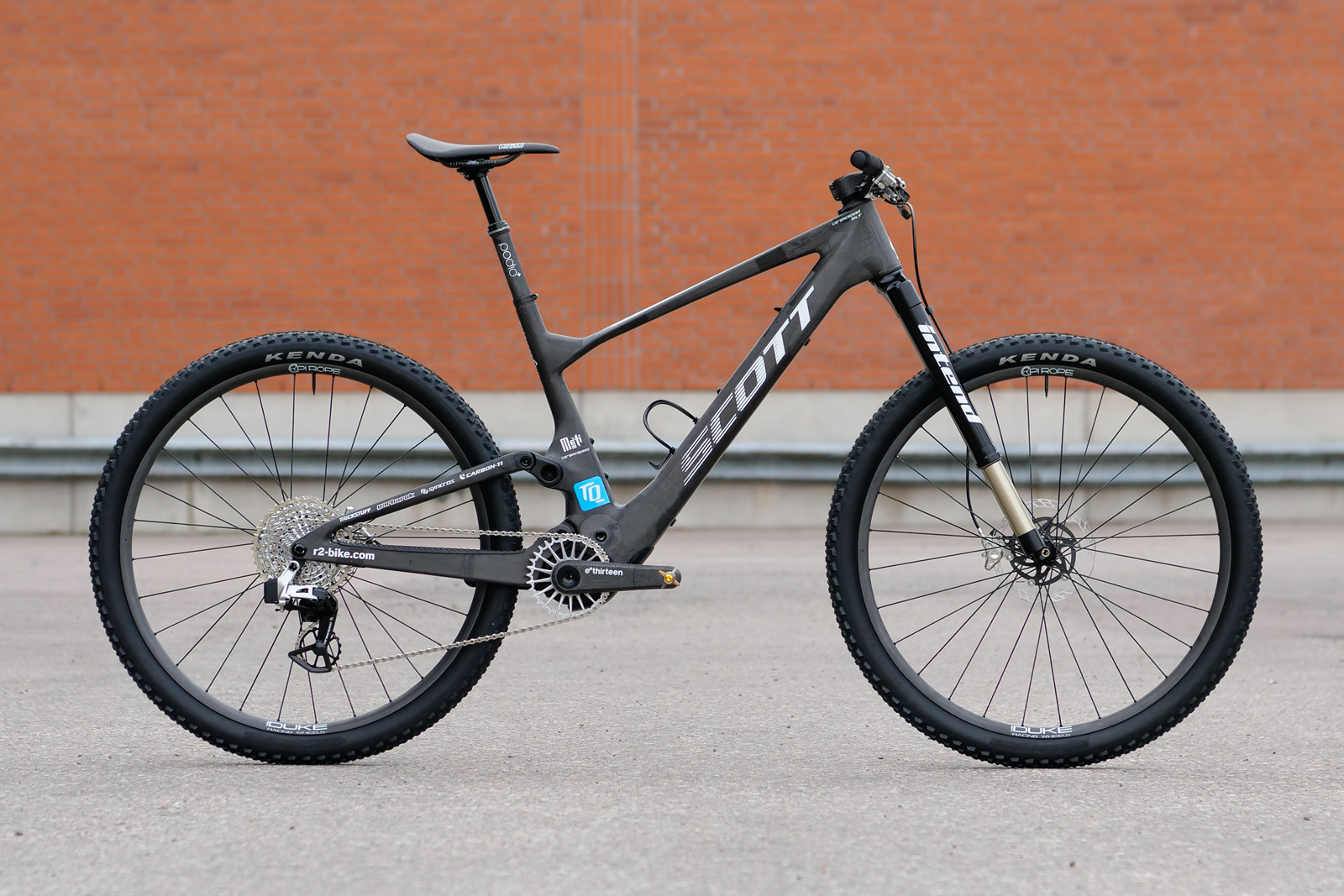Dangerholm is back with a 12.9 kg (28.4 lbs) build of the Scott Lumen eRide eMTB, making it the lightest eMTB in existence. That number pertains to Gustav Gulholm’s personal take on what a XC-oriented eBike should be; with 130mm travel front and rear, the Lumen eRide benefits from the Intend Samurai TR fork, Pi Rope wheels with Duke rims and Nonplus hubs, the TQ-HPR50 motor with CeramicSpeed bearings and a carbon-cased battery, Carbon-Ti brake rotors… to name but a few of the extraordinary components that have gone into creating this extraordinary eMTB.
Then, for broader appeal, there’s Dangerholm’s Trail version of the Scott Lumen eRide. Out of the box the complete 900 SL build comes in at around 15.5 kg, excluding pedals. Gustav’s weighs just 13.93 kg (30.7 lbs). This one is a little more beefed out to handle the rigors of more challenging trail riding.
Dangerholm’s bike building mastery and incredible attention to detail is showcased here in two of the most impressive eBikes you’ll see this year. Who better to tell the full story than the man himself?
Dangerholm’s Scott Lumen eRide – The World’s Lightest eMTB
Words by Gustav Gulholm
This time the plan was as simple as it could be – build the lightest possible E-MTB using the SCOTT Lumen as base. Partially out of curiosity, how light can you actually go? But also with the vision of creating an E-MTB that would feel very close to a regular mountain bike to ride, but with a fun boost at the push of a button.

Simple, yet of course quite complicated. It’s one thing to build something light, and another to truly push the limits and build the world’s lightest in its category. Especially so since it still has to be fully usable while maintaining great ride qualities, because to me there’s no point in building a ”show bike”. Bikes are meant to be ridden.
With that said, when it comes to upgrades and full custom builds I’ve always tried to push the idea that you should build the bike for yourself and no one else. We all have different preferences, riding styles, rider weight and so on and this means you can go in different directions.
One example of this is of course how light components you can “get away with”. And while there are perhaps surprisingly few components on this bike with rider weight limits lower than you normally see, the spec list is chosen with my own body weight and riding style in mind.
But the Lumen is an incredibly versatile chassis, being capable of everything from pure XC riding to the trail and downcountry stuff. And pushing the build so far into XC territory, I figured that I might as well get a few select extra components for more heavy-hitting trail duty and get myself a 2-in-1 dream bike.
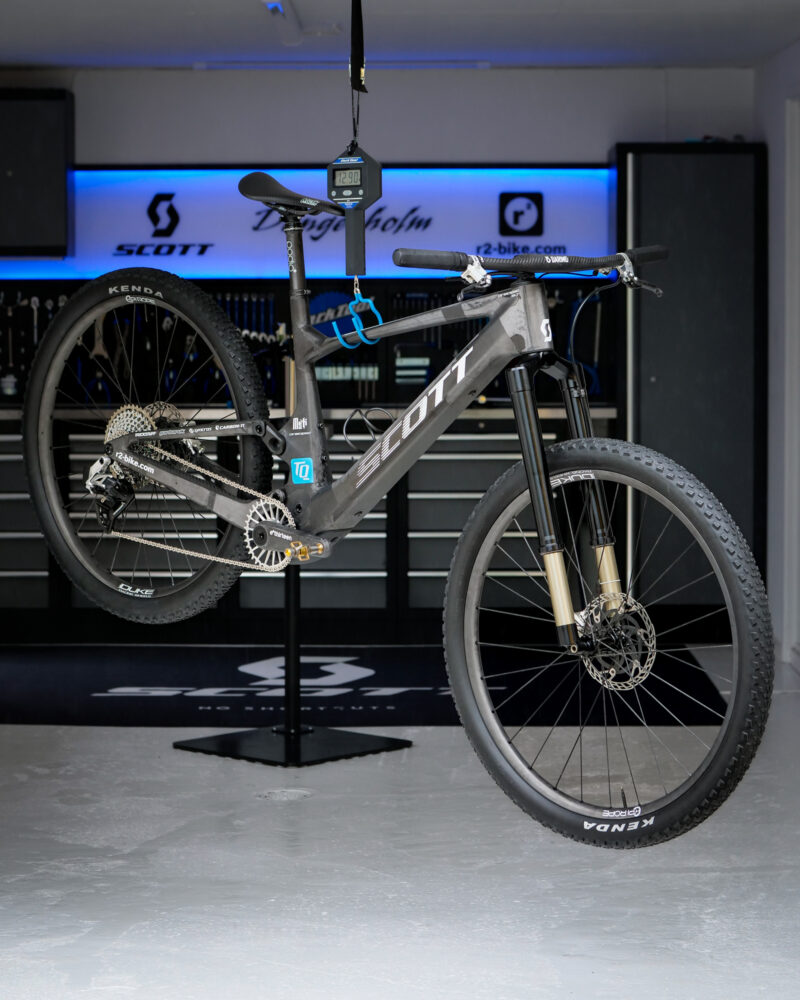
I also figured that a super light and fun focused trail build would be something more riders could relate to personally, so it would be cool to show that side of the Lumen as well.
And this is why you’ll find not just the 12.90 kg record weight version presented below but also a trail/down country version of the very same bike. And if I may say so myself, at around 14 kg that might be equally impressive considering the type of riding it can handle.
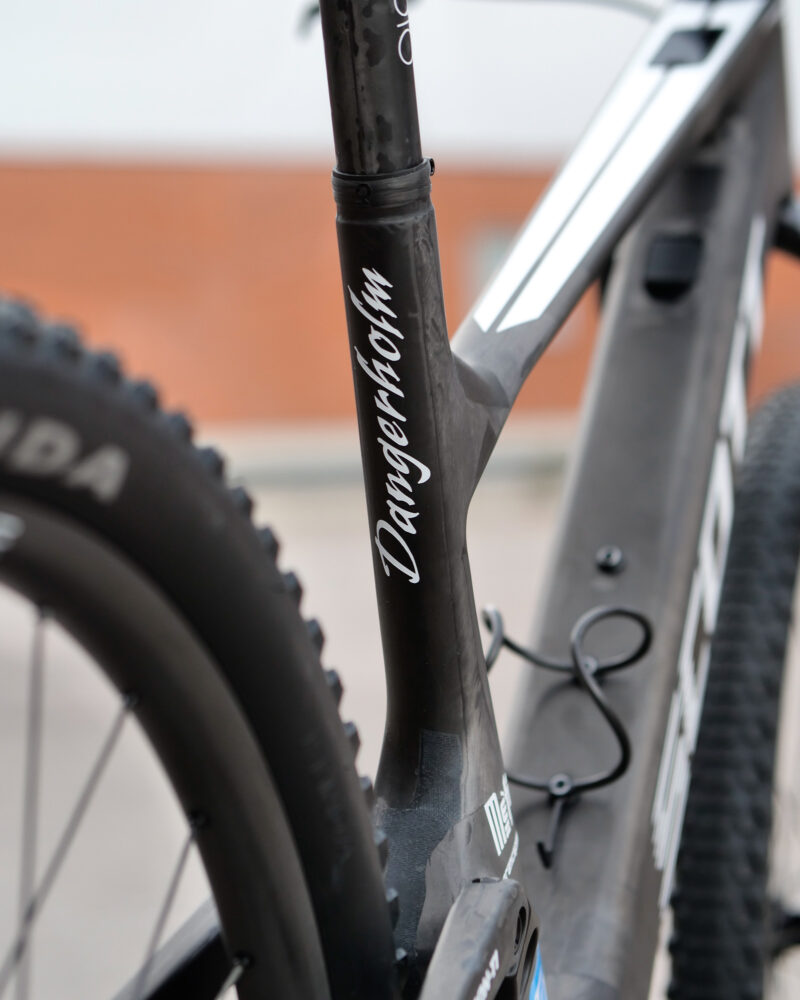
Frame
For those of you not familiar with the SCOTT Lumen eRIDE series, it’s essentially the e-bike version of the SCOTT Spark. Aside from having the rear suspension travel bumped up from 120mm to 130mm, and a slightly different shape to accommodate the TQ drive unit and battery system, it shares the geometry and many of the features. Most obvious is of course the fully integrated rear shock, but you also for example see the easily adjustable headset cups to change the head angle.
Impressively enough the volume of the frame is just 17% bigger than on the Spark, and that number alone tells you that this is a very discreet looking e-bike.
In true SCOTT fashion it is also very light weight. Stripped from paint (which was around 150g) it weighs just 2,072g including hardware. Even after adding the rear shock and rear axle it’s an extremely competitive weight for a trail e-bike frame.
As for the paint stripping itself, I prefer to do most of the work using knives when the end goal is a raw carbon fiber surface. This quite literally sounds very brutal but done correctly it’s a very safe method. It’s not faster than sanding, but it allows me to remove all the primer and possible filler with minimal impact on the carbon fiber. In fact, since I’m so careful you can even still see scratch marks from some of the sanding done at the factory when the frame comes out of the mold.
Needless to say though, removing the paint from your frame is not encouraged by SCOTT or any other bike manufacturer for that matter. It will always void all warranties, and may be dangerous if done incorrectly.
Out of the box the complete Lumen eRIDE 900 SL comes in at around 15.5kg excluding pedals.
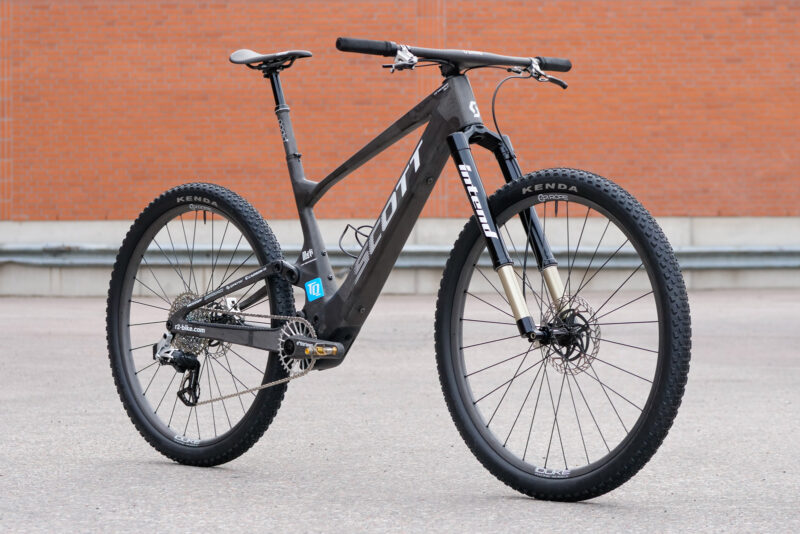
Suspension
Hidden inside the frame sits a remote controlled 3-position RockShox NUDE 5 RLC3 rear shock from a SCOTT Spark RC, which I replaced the stock Fox shock with due to its slightly lower weight. The Fox comes with a bigger air chamber and is more trail oriented, making it the logical choice for the stock Lumen, but the RockShox is still a very good performing shock. And saving close to 40g it made sense for this special project.
Up front you find an Intend Samurai TR 130mm fork. At 1,537g it is as far as I know the lightest 130mm fork currently on the market, but there is a lot more to it than just low weight.

Intend is a small company out of Germany, and was for a long time run as a one-man show by the founder Cornelius Kapfinger. From the very beginning, upside-down forks were the main product because he was a firm believer in the benefits they offer.
One of these benefits is actually especially suitable for e-bikes which tend to be heavier and see higher loads than normal bikes: the crown section which becomes super strong thanks to its bigger proportions. So while the Samurai is marketed as a XC/Trail fork it has been tested to way tougher standards. Other benefits of such a fork design is for example great lubrication, lower unsprung mass and less binding during heavy compressions.
As for upside-down forks having a bit more wheel flex than conventional forks, well, this is where it comes down to personal preference. As for myself, I think it’s a good thing for performance. That tiny bit of flex allows the front wheel to track and follow the terrain better, meaning there’s less chance of getting pushed off from rocks and roots. This results in better grip and a smoother ride with less arm pump.
On the other hand, if you want an ultra stiff bike or if you’re a heavy rider who loves nothing better than pushing berms in the bike park, then maybe they’re not for you. Once again, if you’re building a custom bike for yourself you should optimize it for your riding and enjoyment. The TR version comes with Intend’s own cartridge, not featuring any lockout or remote.
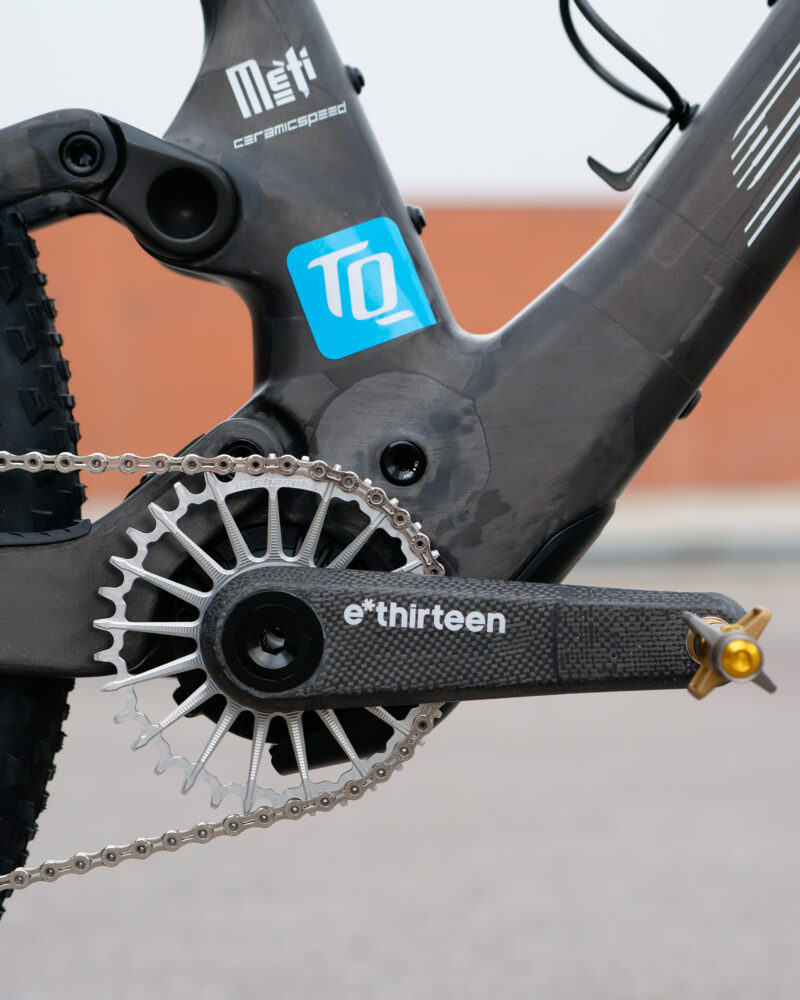
Drive Unit
Now we’re really getting to the heart of the bike – the TQ HPR50 drive unit.
To my big luck I was able to work closely with the incredibly passionate team at TQ for this project, resulting in a super light one-off setup with zero compromise in performance.
But let’s start with the already impressive stock HPR50 since it’s such a crucial part of the Lumen. As the name suggests, the drive unit has a 50Nm max torque which is more than enough for a lot of riders and types of riding. It has a very smooth and nice power delivery, but what’s really cool is how silent it is and how little you notice it with the assistance turned off. You can barely hear it at all even at max output, and you’d have a hard time in a blind test to tell that it’s there when riding above the max assisted speed or with the system turned off.
It comes with a 360Wh battery hidden inside the down tube, with an optional bottle-style 160Wh range extender. The system can of course be configured and personalized via the TQ app.
The TQ HPR50 already is one of the most compact and lightweight drive unit systems on the market, so how do you improve what’s already great? This is where the TQ team came in, with a bit of help from CeramicSpeed and METI.
First of all, the bike was upgraded with a lighter than stock main cable. Then the truly next level tuning began.
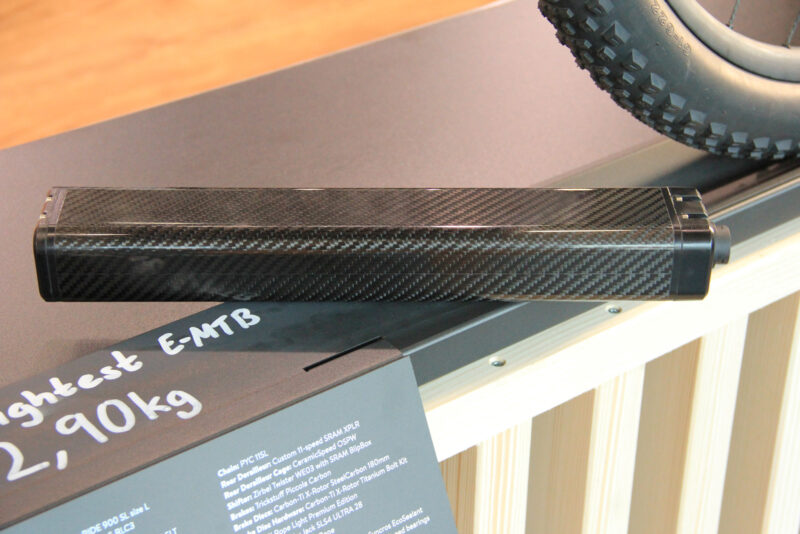
As a R&D project TQ set out to make a one-off carbon fiber housing for the internal battery, complete with proper shielding and so on. The result is a battery that keeps its 360Wh capacity but weighs 206g less. A prime example of the best kind of weight saving, where you lose zero performance.
As a bonus it also looks absolutely beautiful, and it’s quite the shame to hide it away inside the frame.
The HPR50 drive unit also got to see some prototype one-off tuning, with all the bearings being replaced with CeramicSpeed bearings special to this project. Not only does it slightly help with efficiency and making the bike feel even more like a regular bike, but it also saves a whopping 40g.
Finally, the Italian titanium expert METI manufactured custom hollow titanium mounting bolts for it. Almost half the weight of the stock steel bolts, with 32g versus 63g. All in all the tuned TQ-HPR50 system on this bike comes in at 3,783g, with an extra 26g for the remote.
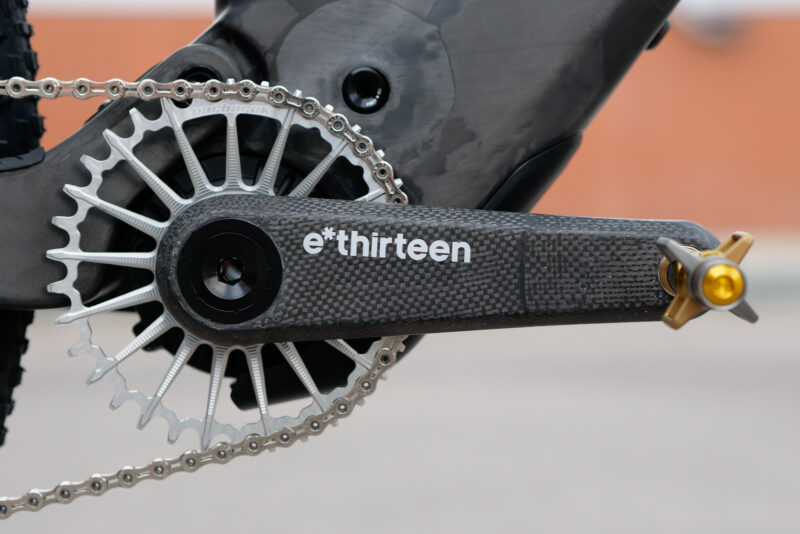
Drivetrain and Shifting
Another area where I knew there was weight to be saved, was the drivetrain. Early on I decided to go for 11-speed, as it’s lightweight and in my own opinion plenty of gears considering it’s an e-bike. My original idea was to use a carbon-tuned mechanical derailleur since it would be the absolutely lightest, but as it felt a bit outdated for such a modern bike I started looking into an electronic solution.
This led me to come up with a very unique, and quite experimental, derailleur setup. In essence it is two different derailleurs combined into one.
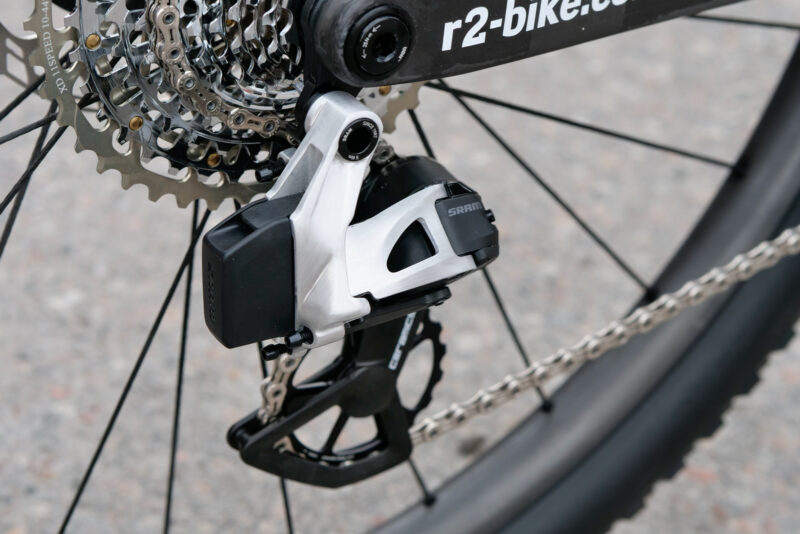
The main base is a SRAM RED AXS XPLR 12-speed derailleur. This is where the parallelogram comes from, as well as the “b-nuckle”, which is the part that bolts onto the hanger and the length of this is part of what decides who big of a cassette the derailleur can handle. In this case it has a 10-44T maximum cassette range capacity.
But how to make it 11-speed? This is where it became really tricky, as I didn’t just want to mechanically limit a 12-speed derailleur and risk damage down the road.
The solution came to use a “p-knuckle”, which is the black composite part housing the electronics and clutch system, from the updated SRAM RED eTap 11-speed road derailleur. It got a complete overhaul a couple of years ago, and now features the same outer dimensions and Orbital Clutch system as the 12-speed XPLR. But the internals is what makes it 11-speed.
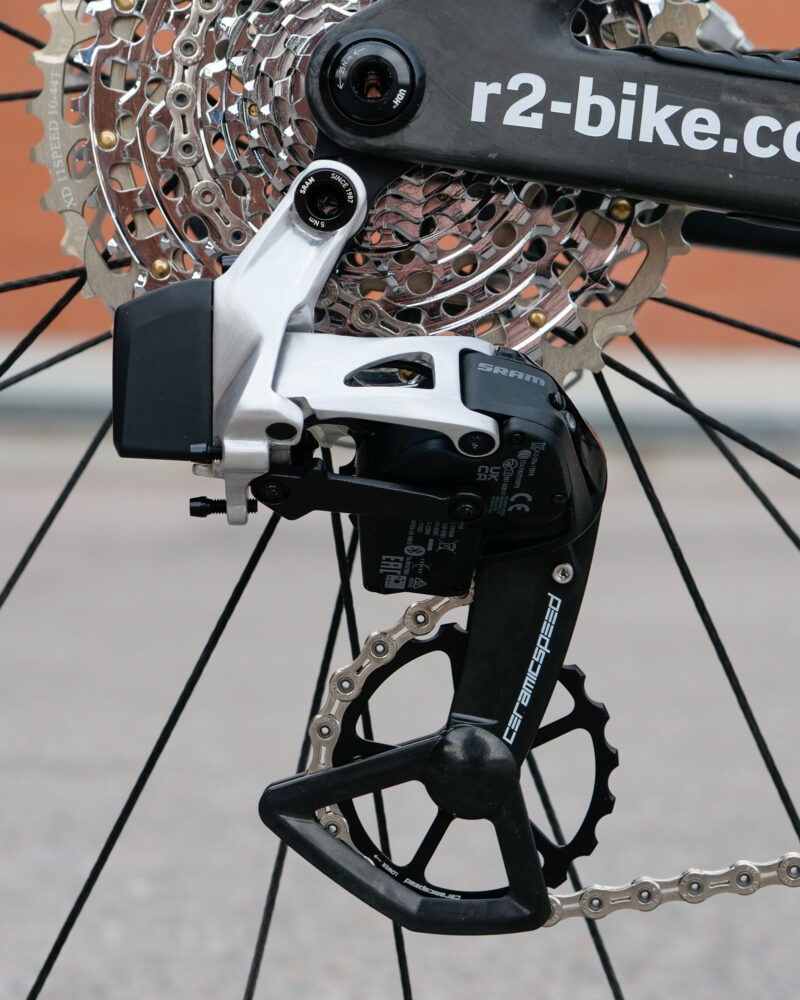
So I simply (ahem…) took both derailleurs apart and made one unique wide range 11-speed derailleur out of them to use on this bike. And in the process I gave it a brushed looked and a bit of Dremel action.
It has to be stated that while I got it to work on my own bike, it is highly experimental and of course warranty voiding custom setup. Everything fits together perfectly as such, but if I’ve done my home work correctly there’s an ever so small difference in cassette spacing between the two systems. This could result in setup issues and possibly shortened drivetrain wear life.
If you’re a real tech nerd you’re probably asking yourself by now: How did he get an eTap derailleur system to shift on a flat bar mountain bike?
Luckily for me these eTap derailleurs became compatible with the latest AXS road shifters and more importantly, the latest SRAM AXS BlipBox, during this product update.
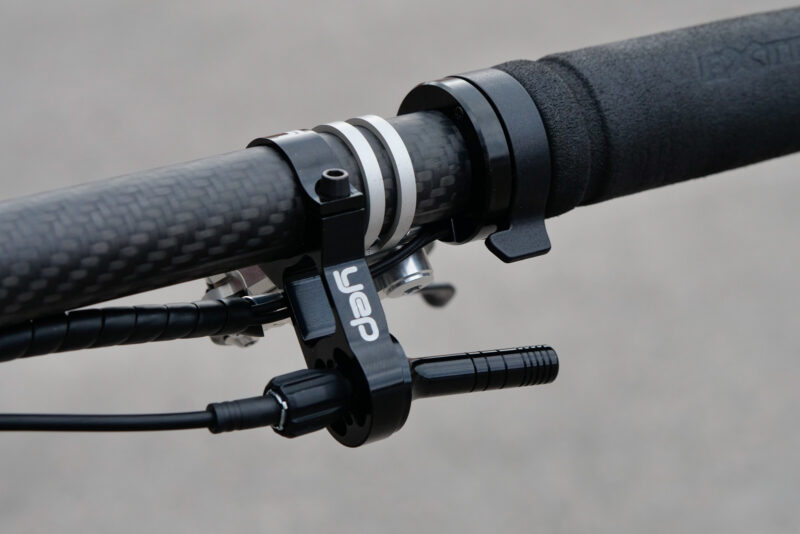
So, for shifting I’m running a Zirbel Twister WE05 controller which is plug-and-play with the BlipBox. These super cool little controllers come in several versions, and despite their minimalistic look they’re actually incredibly ergonomic and easy to use out on the trails.
The shifter ring rotates on a bearing, and the click mechanism is small but has strong magnets. This gives the Twisters a bit more “travel” compared to other electronic controllers, making the action very distinct while still feeling more natural like traditional mechanical shifters.
The SRAM BlipBox itself is then hidden inside the frame, just behind the steerer tube, wrapped in foam to keep things nice and silent.
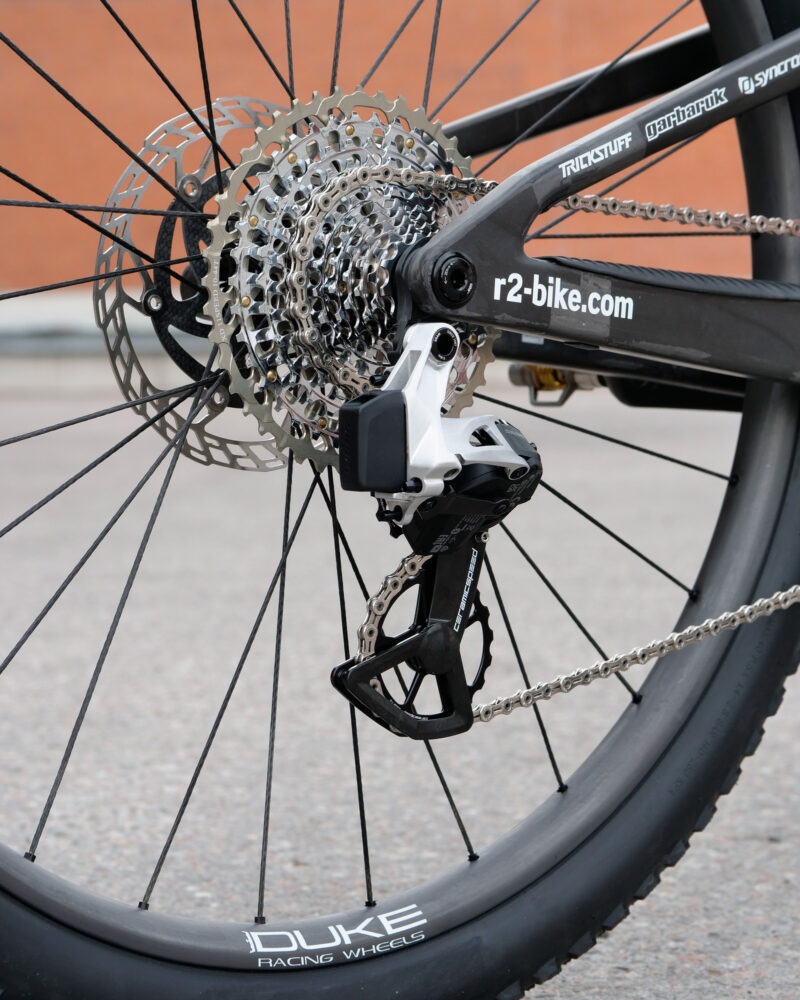
The cassette is another somewhat experimental part, as it’s an early production sample from an Asian brand called SixWheel. They are currently reworking their catalogue with updated designs and sizings, so I won’t go too much in depth at this point. But shifting is smooth, it’s a high-end and definitely expensive product and it’s also incredibly light. The chain is a PYC 1101 SL.
At the front there’s the super light ethirteen espec Race Carbon crank arms in 170mm length. These where also stripped from paint, revealing a beautiful and super cool looking 3k carbon weave finish and brought the weight down to 328g.
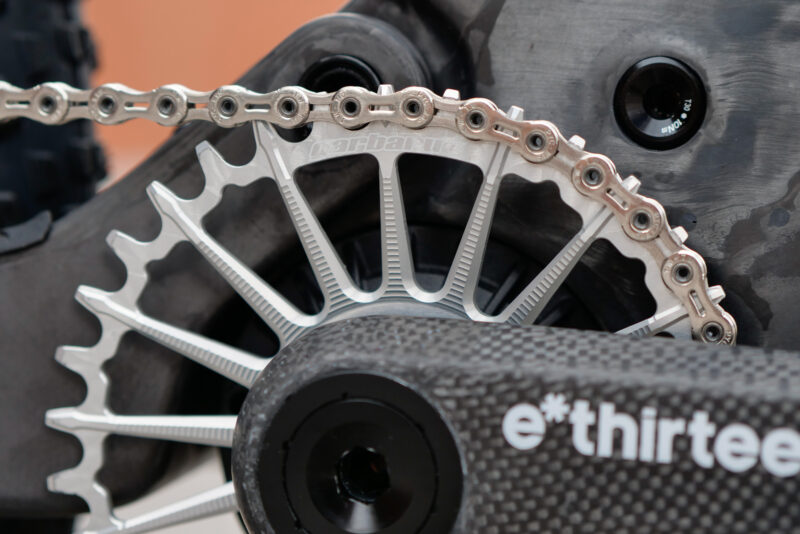
The chainring is another prototype part. Having used Garbaruk chainrings for many years now with great results, I reached out to them to check if it would be possible to make a TQ compatible direct mount chainring for this bike. To no big surprise, they came back with an absolutely beautiful chainring that is half the weight of the standard spider setup.
If you take a closer look you’ll see that the spokes actually become the wide teeth, meaning that every size features a different number of spokes. You’ll see more of this design in the future as the plan is to offer it for their own cranksets, but I sure hope that e-bike versions will hit the market as well.
When going for the absolutely lowest weight, few pedals can beat the tried and tested Crankbrothers Eggbeater 11 Ti SL which is what I’m using for this XC version of the bike.
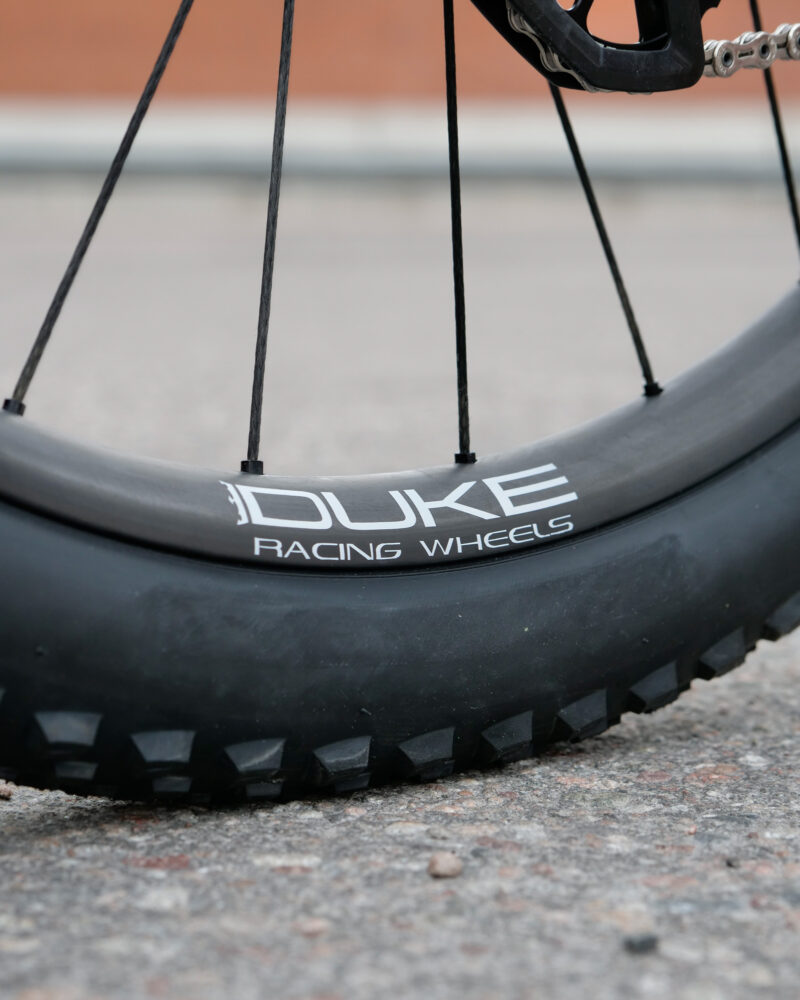
Wheels
At just 945g these Pi Rope wheels featuring Duke rims and Nonplus hubs are not your ordinary e-bike wheels.
As the name suggests, Pi Rope doesn’t build their wheels with conventional steel spokes but as a system with synthetic fiber rope spokes. Holding one of these spokes in your hand feels completely surreal, as they feel just like any super light string and you literally can tie a knot with one. At the same time these Vectran fiber spokes have a higher tensile strength than a normal steel spoke.
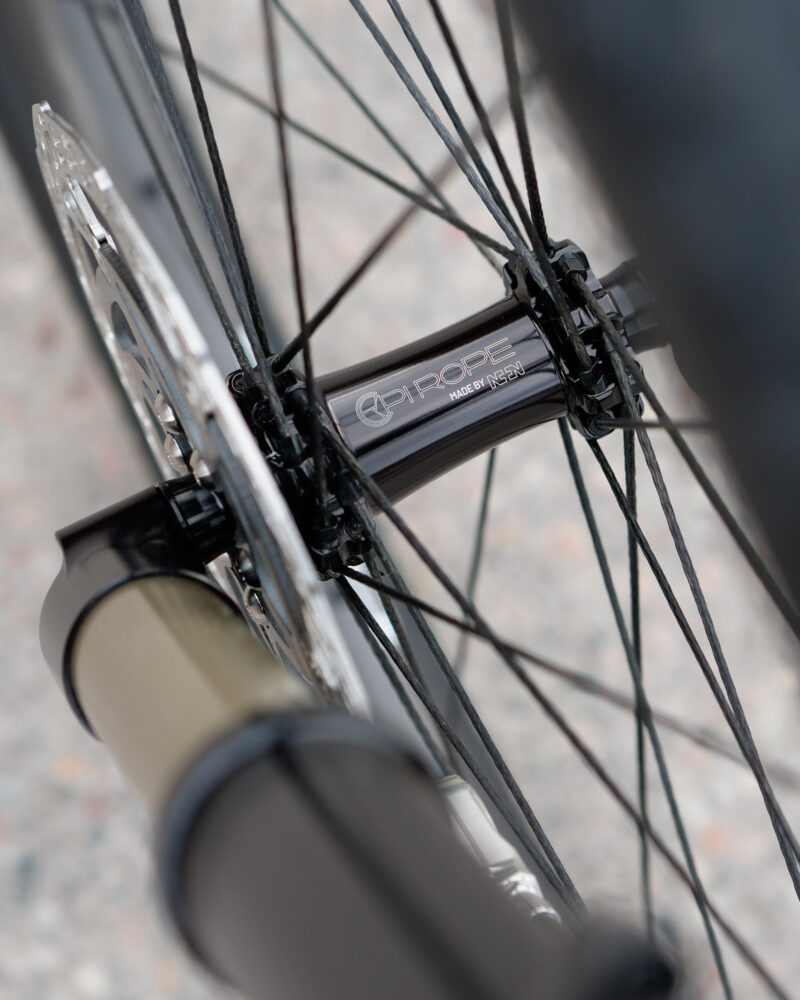
The hubs are another German creation, from the rather new brand called Nonplus. Not only are they some of the lightest hubs on the market in general, but their unique freewheel mechanism featuring a ratchet system with a much bigger than normal contact surface area makes them the lightest you can get for an e-bike.
The Pi Rope version features a special spoke drilling, but for comparison their traditional J-bend spoke hubs weighs just 167g and 86g, respectively. This is a 50g or more weight reduction on the rear hub alone compared to most other hubs out there.
To complete the wheels you find the DUKE Lucky Jack SLS4 Ultra 28 rims. This is the fourth lightweight generation of the French brand’s XC oriented rim, and Ultra means that it’s the lightest version offered. The non-Ultra rims tip the scales slightly higher but on the other hand comes with a higher 110kg max system weight limit.
28 means that it’s the 28mm inner rim width version, which is a bit lighter than the 30mm Lucky Jack’s. Personally I don’t mind the slightly narrower width, in fact I think there’s a lot to this discussion. For example I like riding my downhill bike with 25mm inner width rims just because of the feeling you get out of the bike, but once again these things come down to personal preference.
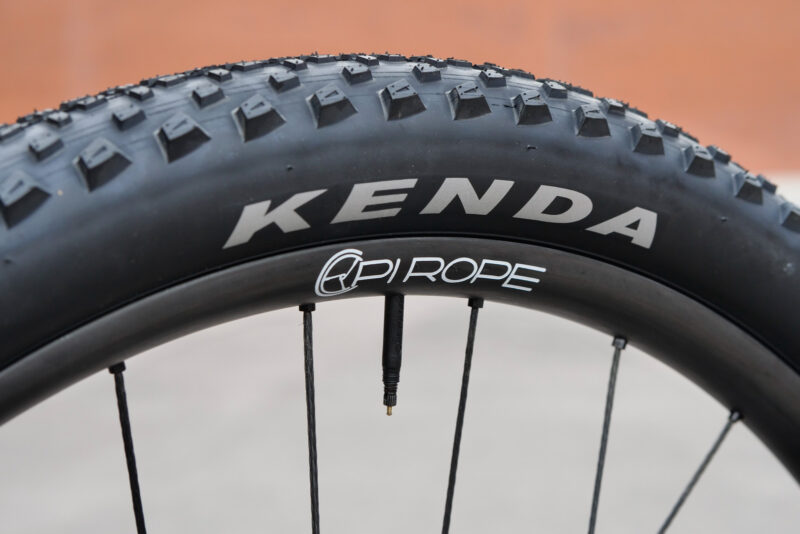
For tires I went with the Kenda Rush Pro TR in 2.4” width. Some of you might be surprised to see Kenda tires on one of the most high-end bikes ever, but the brand has truly stepped it up in recent years and now offer some very interesting thread patterns in various casings.
The Rush is the all-round XC tire with low rolling resistance combined with decent size side lugs for cornering grip, and the weight is an impressive 620g. I also have an optional Kenda Karma 2 with a grippier tread pattern to use as front tire, and in case you’re heading into particularly rough terrain these tires also come in a reinforced SCT casing version.
The bike is mainly setup tubeless with Syncros Eco Sealant, which I’ve had good luck with in the past. But if you truly want to count grams I also have some Revoloop Ultra MTB tubes for it, which actually puts the total weight of the bike down to 12.85kg. These are not just incredibly light but also super compact making them the perfect spare tube to bring on your ride.
But sometimes, for example when having big training blocks of riding in easier terrain, I still use tubes on my XC and gravel bikes and then these are a great choice.
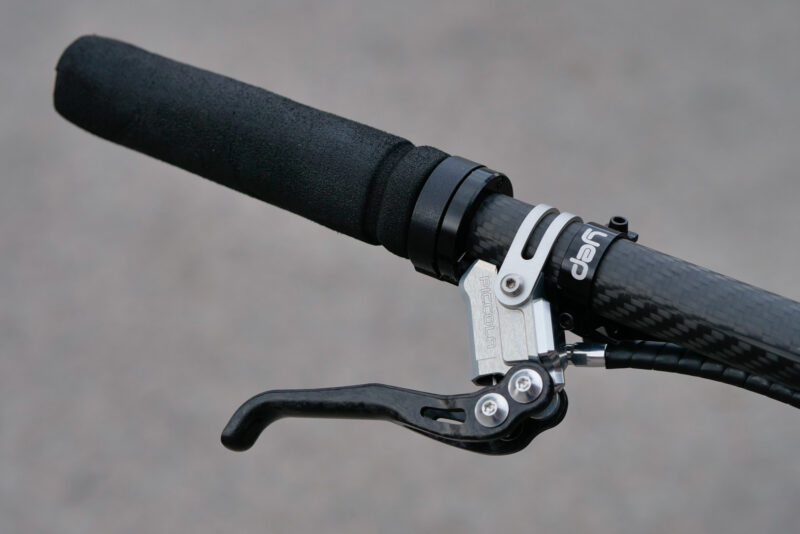
Brakes
The world’s lightest e-bike of course needs the world’s lightest brakes, which are the Trickstuff Piccola Carbon. But the best part with these, along with the amazingly smooth and nice lever feel, is that they’re also some of the more powerful 2-piston brakes available.
Having the lowest weight while maintaining top performance is a rare feat, and as a bonus the fully machined design is very beautiful as well.
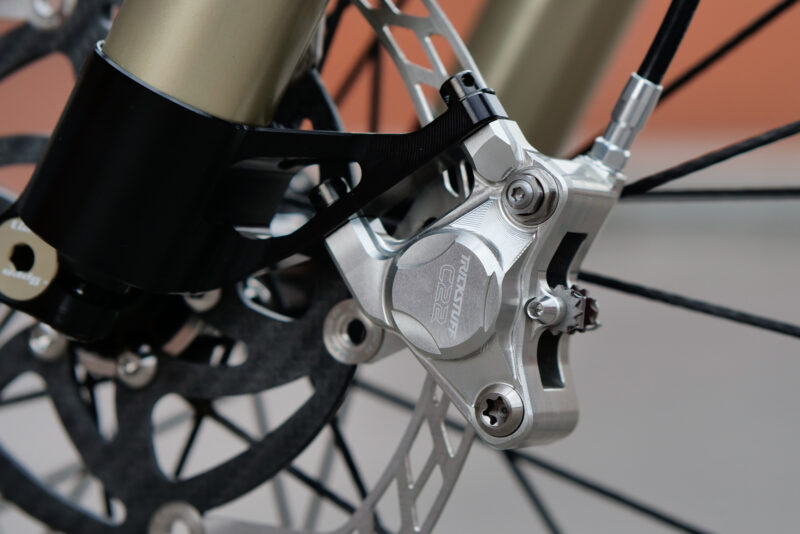
One interesting detail is the Flat Mount front C22 caliper, made possible for MTB use thanks to the Intend fork. It gives a very clean look, and is ever so slightly lighter.
Italian brand Carbon-Ti makes the truly unique brake discs, called X-Rotor SteelCarbon which I run in 180mm front and rear size. Another fantastic looking component, that I’ve in fact been dreaming about for years.
The carbon fiber carrier is of course super light, meaning that you can have more material in the steel braking surface than on an equivalent weight traditional brake disc.
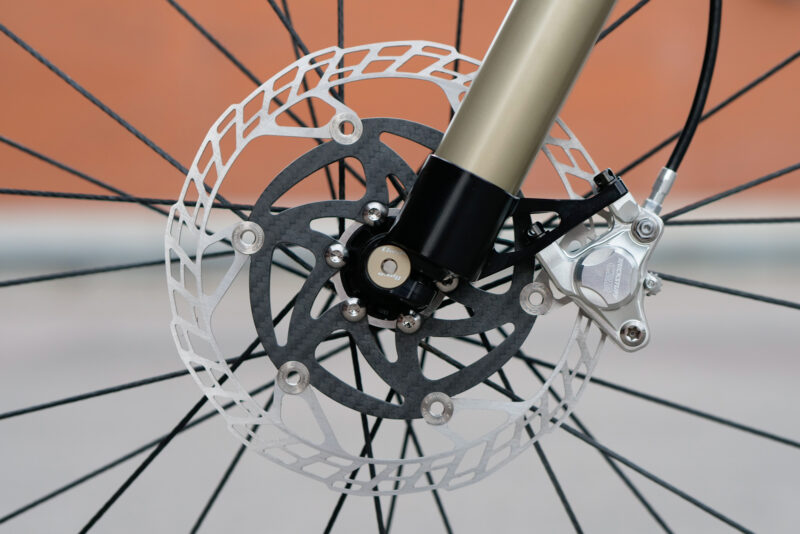
On the XC version of the bike I’m running the 2nd generation of these, installed with Carbon-Ti titanium bolts. The Trail version features the 3rd and latest, just released, generation which has seen some small changes. There has been some optimizing of the design, as well as the discs getting rounded edges on the steel section. These are also now available with center lock adapters, which is why you see them on Syncros wheels setup further below.
If you’re worried about seeing carbon parts in a brake system, these discs are actually very well proven and also being raced at the highest level in for example Tour de France seeing riders hit 100km/h before slamming on the brakes.
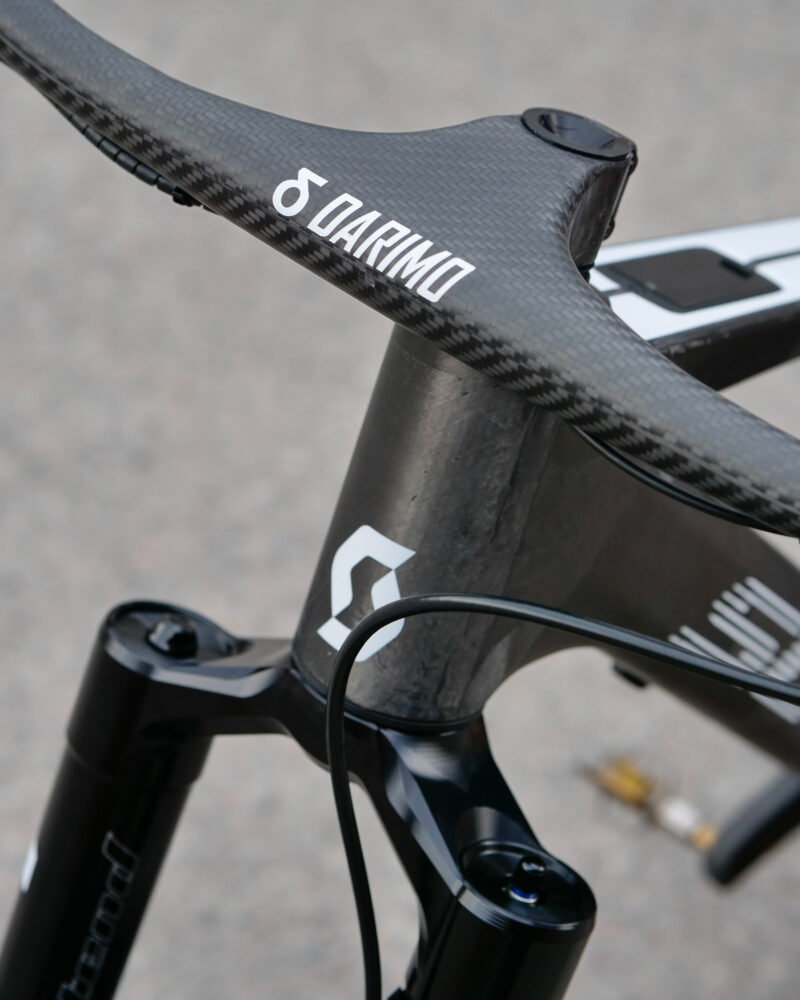
Cockpit
Starting with the headset, I’m running the standard Syncros cups, but with a CeramicSpeed SLT upper headset bearing. SLT is short for Solid Lubrication Technology, meaning that there’s no traditional grease inside the bearing but a solid plastic polymer filling. This means that there’s no grease that can get pushed away or dry out, and as such no dirt can enter.
While you might assume that these are ceramic bearings, they’re actually fully made from stainless steel as they deemed it best in this application. All in all it should offer a very long and essentially service free bearing life.
The lower bearing has been changed to an Extralite UltraBottom bearing kit which saves weight.

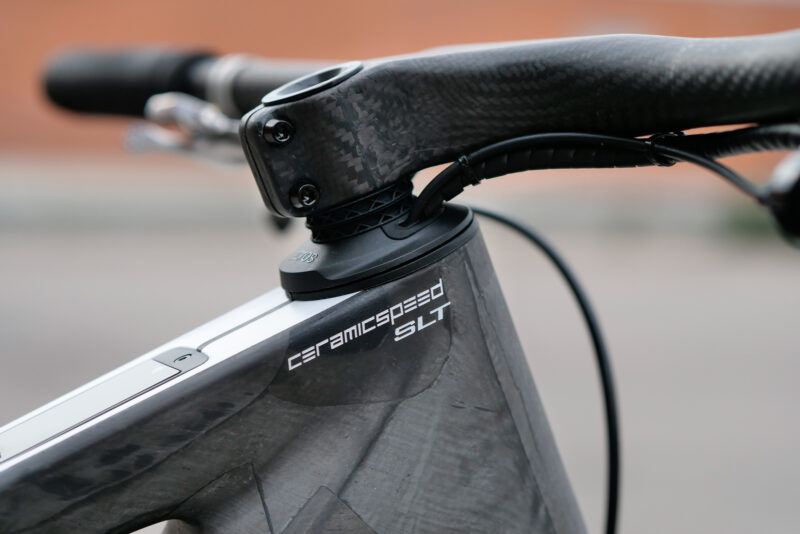
On top there’s a Darimo Epsilon one-piece handlebar unit in 740mm width and 70mm stem length weighing a mere 174g. Made in Spain, these are some of the lightest handlebar setups you can get.
While they’re offered in numerous stem lengths and angles, the really cool thing is that anyone can custom order these to suit their own preferences. Want the lightest possible? No problem. Reinforced for a heavy rider? No problem.
They’ll make a custom carbon layup depending on the customers needs, which is a rare and really nice service to see.
The very light and very cool looking top cap is actually the first look at my Dangerholm Signature top cap from German CNC-experts RadoxX. It weighs just 4g partly thanks to a hollow special made bolt, so keep an eye out for more on this and many other special parts to follow.
Grips are Extralite HyperGrips which weigh just 11.8g including the end plugs and are glued (wooden glue or hairspray from my punk hair style days…) on to stay in place.
The rear shock remote on the left side of the handlebar is a customized Scott Twinloc.
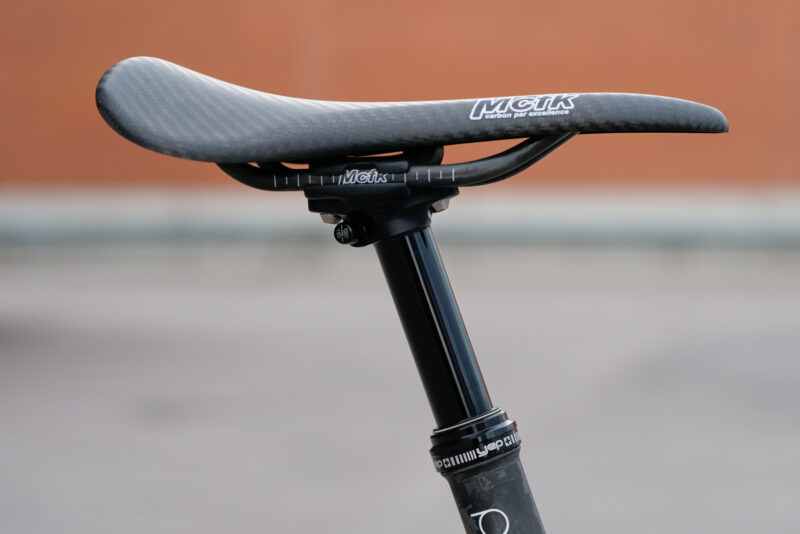
Seat Post Combo
Up top there’s an MCFK full carbon fiber saddle in 130mm width. This is actually one of my all time favorites and I first used it back in 2017. While you might think that such a saddle is very uncomfortable and like sitting on a rock, this couldn’t be further from the truth.
The thin carbon fiber saddle shell actually offers a lot of flex, much like an old-school leather saddle, and you can easily press it down using your thumbs to test it. Another benefit is that the carbon surface means that your bibs or shorts will slide on the saddle when pedaling, rather than creating friction and possibly chafing your body.
The seat post comes from Swiss YEP Components and is called Podio featuring 80mm drop. This can be shortened so the weight usually varies between around 320-340g depending on your setup, making it one of the lightest on the market. The dropper action is extremely smooth and easily actuated, and you can easily disconnect the cable interface from the seat post if you for example need to remove it when traveling.
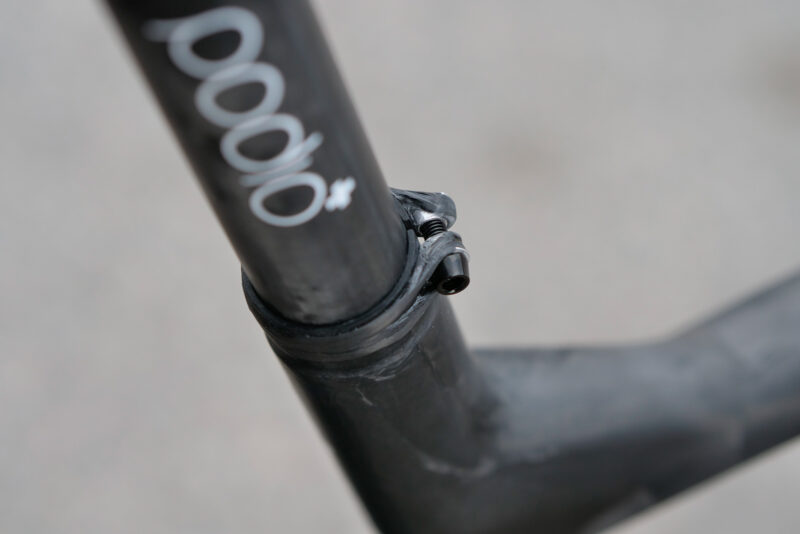
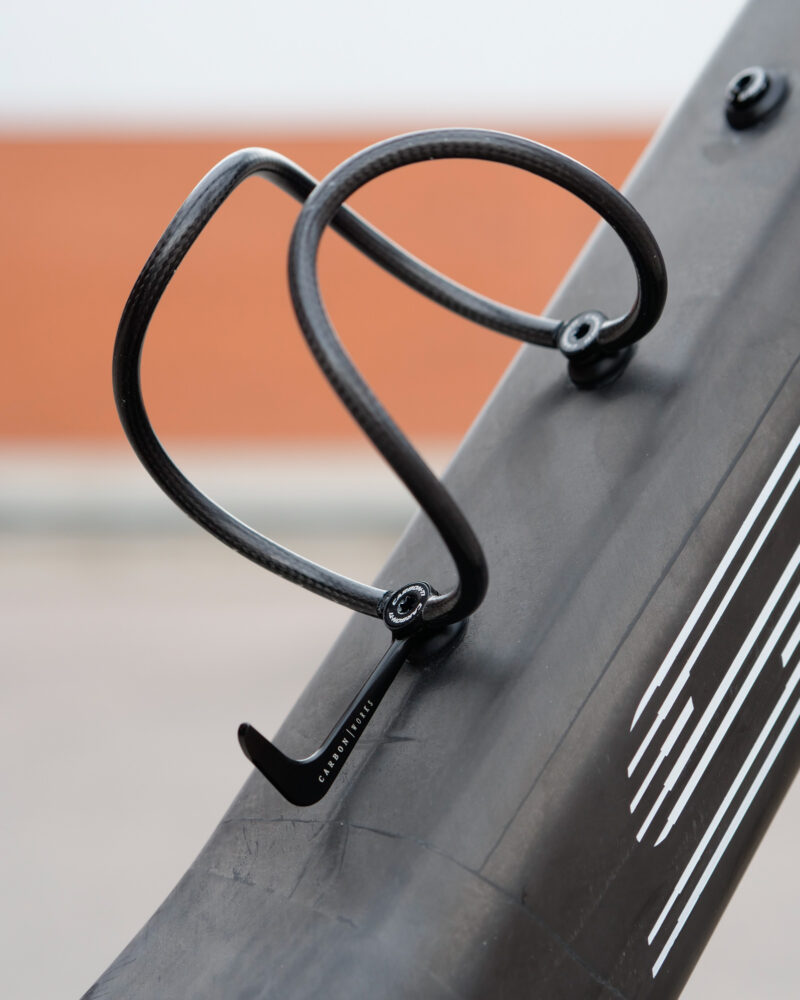
A small but impressive detail is the SUB4 seat clamp from Darimo. As minimalistic as it gets, it weighs less than 4g and still allows for 5 Nm of bolt torque.
To finish the build kit there’s a bottle cage from CarbonWorks. Thanks to the clever design with hollow carbon fiber tubes, which has a rubber coating to combat abrasion wear, it weighs just 9.6g including the bolts.
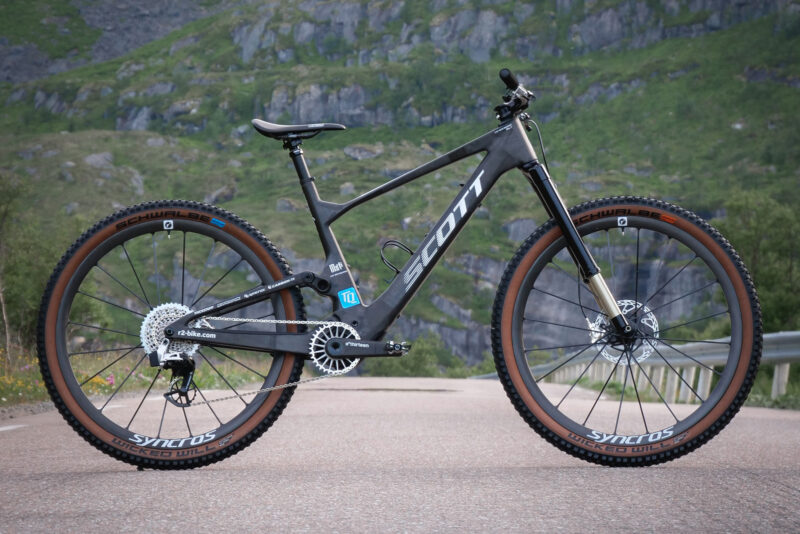
The Trail Version
As mentioned earlier I also decided to build a more capable and fun oriented trail or downcountry version of the bike. While the crazy light XC spec for sure feels like a rocket, it makes a lot of sense to go for a more all-round build on an e-bike. But of course the goal was still to keep weight to a minimum, and the result is a 13.94-14.04kg trail bike depending on tire setup.

The changes are the following:
- Wheelset: At 1,256g the Syncros Silverton SL wheels are still featherweights but at the same time surprisingly strong and durable. The full carbon construction, with carbon spokes where the fibers go from one side of the rim all the way over to the other, makes them very unique wheels for a mountain bike. The rims, spokes and hub flanges are molded in a single step with the hub section then inserted which creates tension in the spokes. Their stiffness and centered weight makes them extremely responsive and fun to ride.
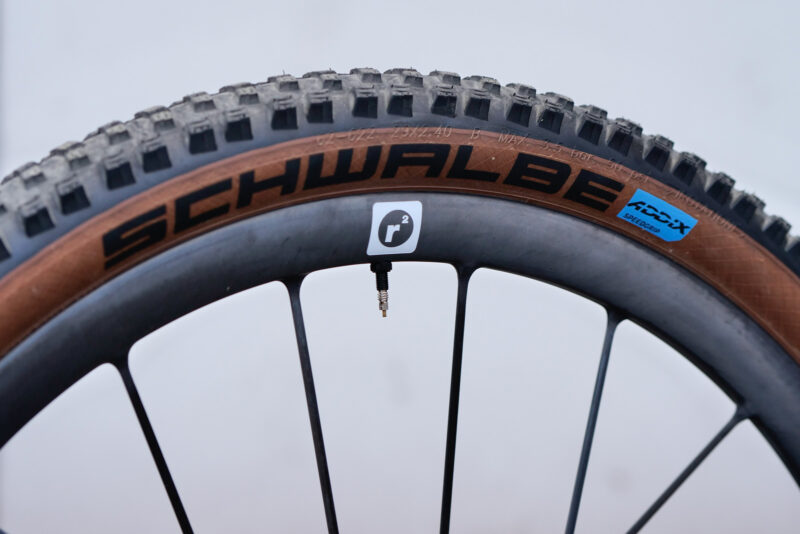
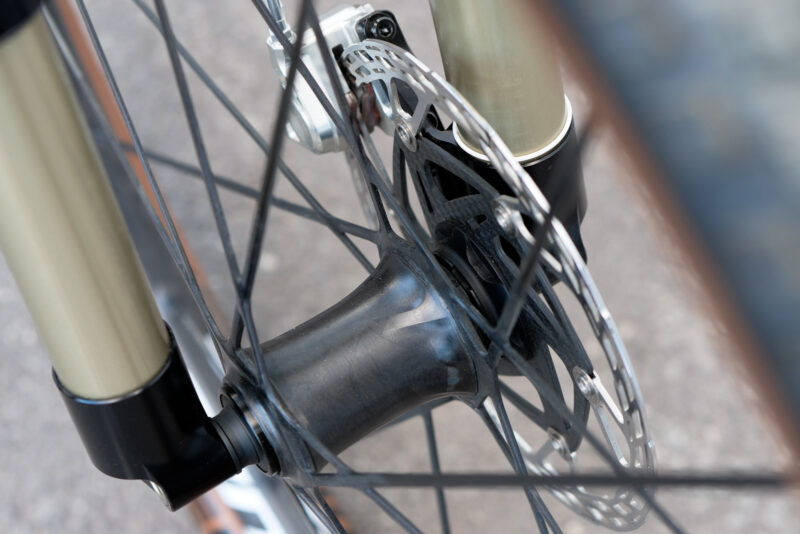
- Tires: I have two main tire setups for this spec. First is the Schwalbe Wicked Will in 2.4” width as you see pictured. To be honest it’s partially because they look amazing against the raw carbon fiber with their skinwall style, but they’re also reasonably light and very good riding tires. Especially with the soft compound version up front. Then there’s the Kenda Karma 2 2.4” in SCT casing. These have in my opinion a very good all-round thread pattern, the SCT casing provides a lot of durability and as a bonus they’re slightly lighter as well bringing the weight down to 13.94kg. Both are setup tubeless with Syncros Eco Sealant.
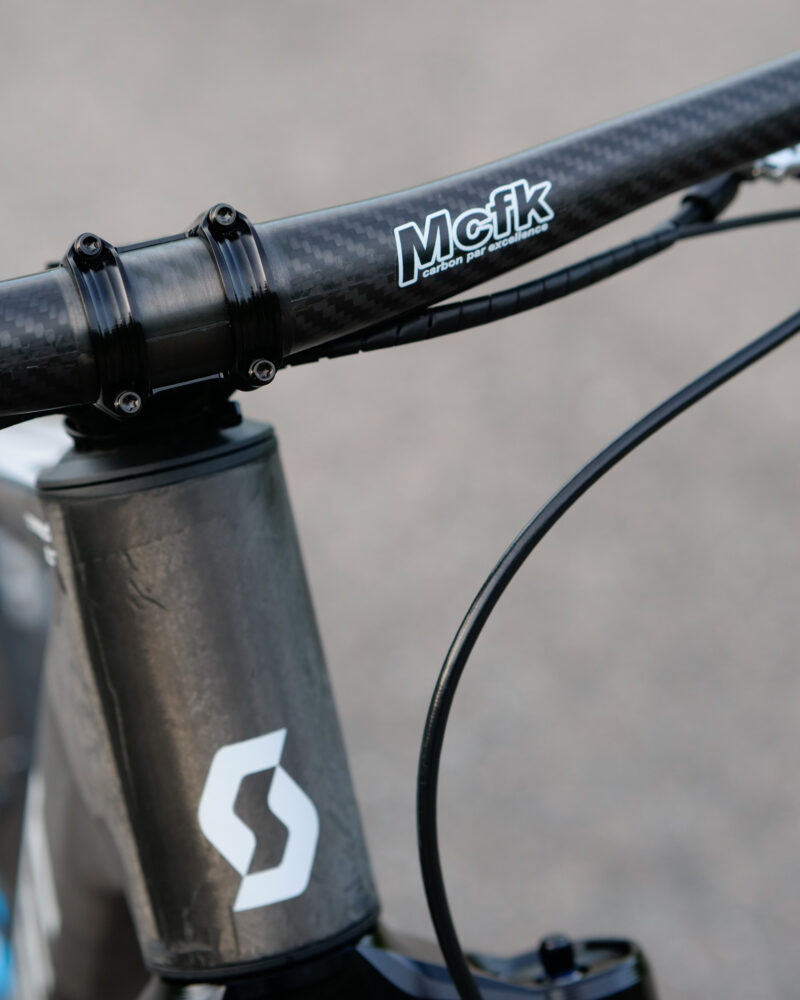
- Cockpit: To have more fun on the downhills and a more relaxed position on the bike, I wanted a slightly shorter, taller and wider handlebar setup.
The handlebar is an MCFK 10mm riser in 760mm width. This XC and Trail focused handlebar comes in a beautiful weave finish and is also offered in various flat as well as 20mm and 30mm rise options. The stem is the Extralite HyperStem in 60mm length and a 6 degree positive angle. The complete combo weighs 186.7g.
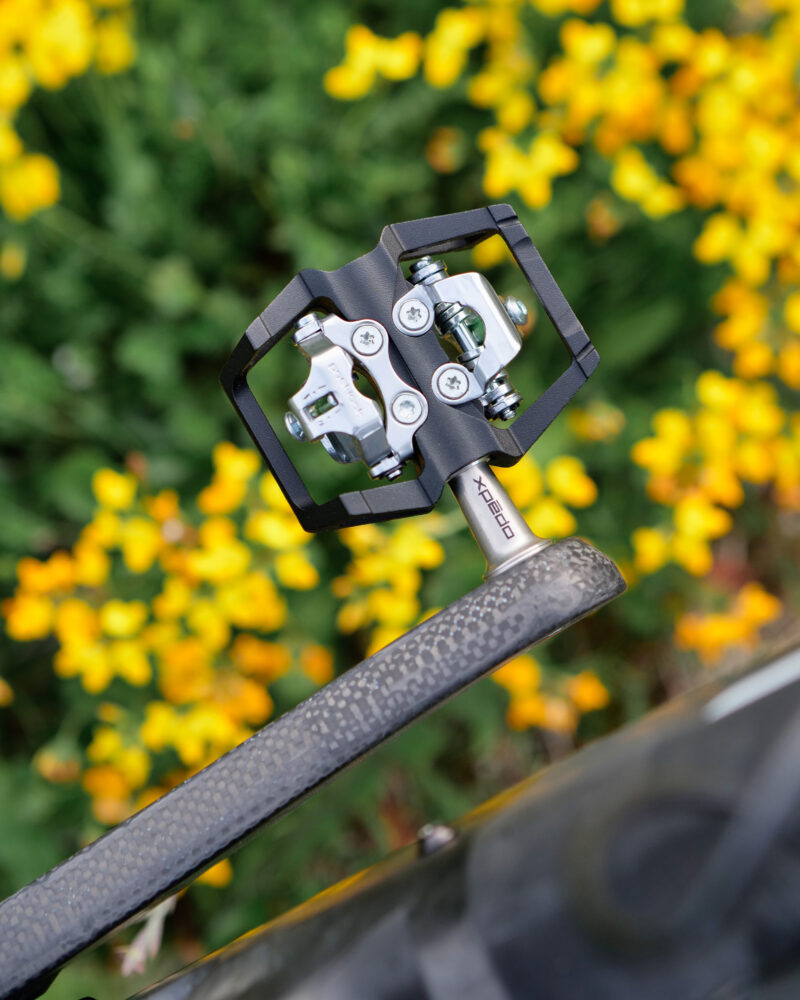
- Drivetrain: To provide a better and more confidence inspiring riding experience I’m running Xpedo Baldwin pedals, which have a more distinct clip-in mechanism and of course offer more support than the Eggbeaters. At 358g they’re still quite light, and I also have a set of Crankbrothers Mallet E 11 Ti which actually are a little bit lighter while having an even bigger platform. I’m currently running this setup with the slightly heavier but well proven 11-speed SRAM XX1 10-42T cassette.
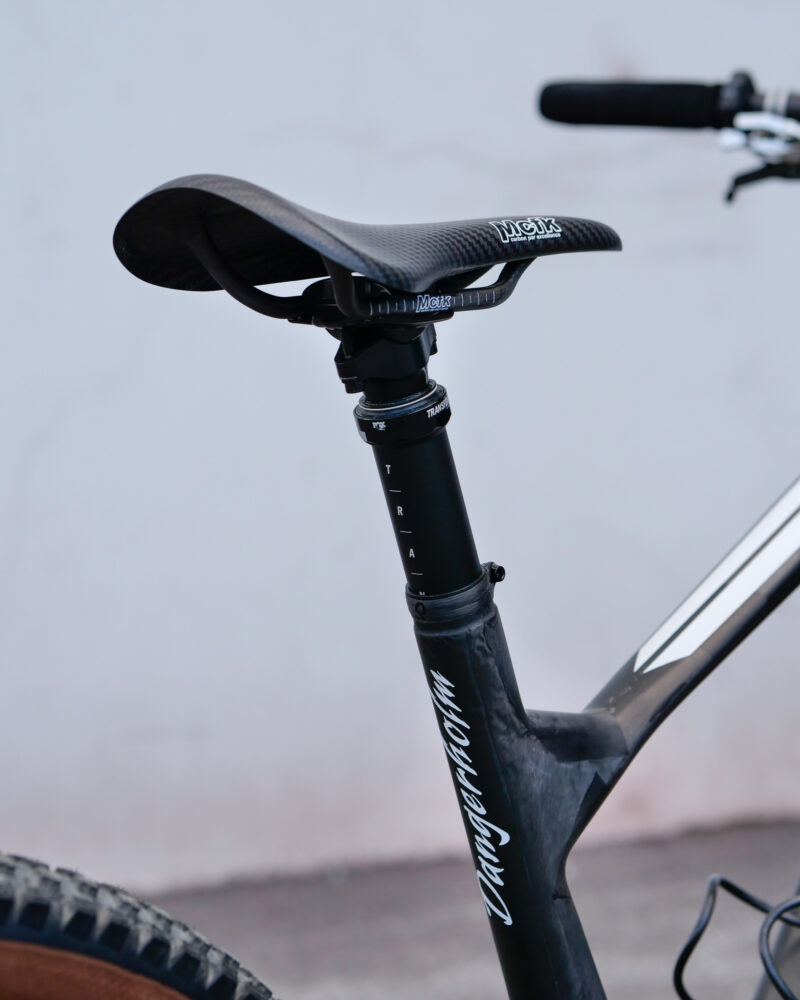
- Seat post: 80mm drop is on the shorter end of the spectrum, so for the trail version I installed a 150mm Fox Transfer SL. Having just two fixed positions it’s a bit different compared to most other dropper seat posts, but it works very well.
We’ll see however in the future if I’ll take the weight penalty and choose to run a regular Transfer in 175mm just to get a bit more drop and the option to run the seat slightly lowered when pedaling very technical terrain.
Summary
In the end this build exceeded my already high expectations, both in the weights that were achieved and also in how incredibly fun this bike is to ride.
It feels so much like a regular bike and I dare say that many would have a hard time, if not impossible, to tell that it’s an e-bike when riding it without the assistance. And this was also a concept I really wanted to push with this build, to perhaps change people’s perception about e-bikes a little bit. That an e-bike doesn’t have to be “unrideable” if you run out of battery, and that you during a ride can opt to just have the assistance turned on when you feel like it.
Sure at this point this is a custom built one-off bike, but I’m guessing that in the future we’ll see one category of e-bikes going far into this direction.
And by the way, the incredible TQ-HPR50 drive unit already offers this which I’m sure riders on stock SCOTT Lumen and other bikes are enjoying already as I write this. As for myself I was truly amazed how much help you get out of “just” 50Nm, and I’d say this is more than enough for plenty of riders.
All in all, my SCOTT Lumen eRIDE 900 SL ended up being a thing of dreams. So is the stock model, but this build takes something already great and pushes it to the next level.
And if I may say so myself, the trail version especially is one very good looking bike…
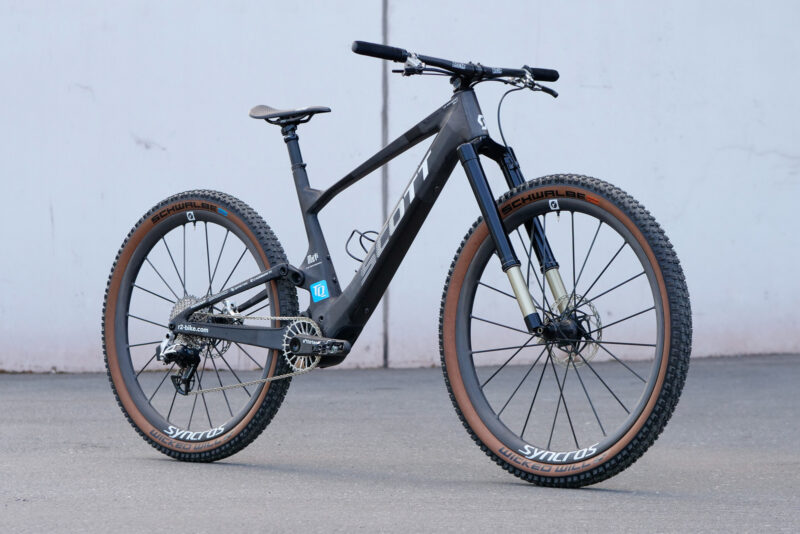
Weights including pedals:
XC Version:
12,85kg with tubes
12.90kg tubeless
Trail Version:
13.93kg with Kenda Karma 2 SCT 2.4”
14.04kg with Schwalbe Wicked Will 2.4”
